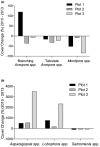Variable responses of benthic communities to anomalously warm sea temperatures on a high-latitude coral reef
- PMID: 25426718
- PMCID: PMC4245080
- DOI: 10.1371/journal.pone.0113079
Variable responses of benthic communities to anomalously warm sea temperatures on a high-latitude coral reef
Abstract
High-latitude reefs support unique ecological communities occurring at the biogeographic boundaries between tropical and temperate marine ecosystems. Due to their lower ambient temperatures, they are regarded as potential refugia for tropical species shifting poleward due to rising sea temperatures. However, acute warming events can cause rapid shifts in the composition of high-latitude reef communities, including range contractions of temperate macroalgae and bleaching-induced mortality in corals. While bleaching has been reported on numerous high-latitude reefs, post-bleaching trajectories of benthic communities are poorly described. Consequently, the longer-term effects of thermal anomalies on high-latitude reefs are difficult to predict. Here, we use an autonomous underwater vehicle to conduct repeated surveys of three 625 m(2) plots on a coral-dominated high-latitude reef in the Houtman Abrolhos Islands, Western Australia, over a four-year period spanning a large-magnitude thermal anomaly. Quantification of benthic communities revealed high coral cover (>70%, comprising three main morphospecies) prior to the bleaching event. Plating Montipora was most susceptible to bleaching, but in the plot where it was most abundant, coral cover did not change significantly because of post-bleaching increases in branching Acropora. In the other two plots, coral cover decreased while macroalgal cover increased markedly. Overall, coral cover declined from 73% to 59% over the course of the study, while macroalgal cover increased from 11% to 24%. The significant differences in impacts and post-bleaching trajectories among plots underline the importance of understanding the underlying causes of such variation to improve predictions of how climate change will affect reefs, especially at high-latitudes.
Conflict of interest statement
Figures





References
-
- Hughes TP, Baird AH, Bellwood DR, Card M, et al. (2003) Climate change, human impacts, and the resilience of coral reefs. Science 301:929–933. - PubMed
-
- Bellwood DR, Hughes TP, Folke C, Nyström M (2004) Confronting the coral reef crisis. Nature 429:827–833. - PubMed
-
- Pandolfi JM, Connolly SR, Marshal DJ, Cohen AL (2011) Projecting coral reef futures under global warming and ocean acidification. Science 333:418–422. - PubMed
-
- Berumen ML, Pratchett MS (2006) Recovery without resilience: persistent disturbance and long-term shifts in the structure of fish and coral communities at Tiahura Reef, Moorea. Coral Reefs 25:647–653.
-
- Loya Y, Sakai K, Yamazato K, Nakano Y, Sambali H, et al. (2001) Coral bleaching: the winners and the losers. Ecol Lett 4:122–131.
Publication types
MeSH terms
LinkOut - more resources
Full Text Sources
Other Literature Sources

